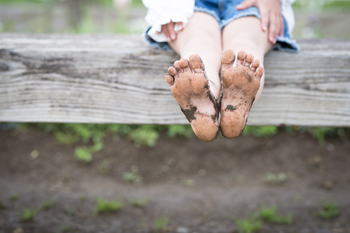
Juvenile plantar dermatosis, also known as atopic winter feet or forefoot dermatitis, is a condition that causes chronic dry skin on the feet. It mainly affects pre-adolescent children between the ages of three and 14. It is slightly more common in boys, and is rarely seen in adults. This problem may happen from repetitive movements causing friction on the feet. Additionally, footwear that is made of synthetic materials, excessive sweating of the feet, or genetic skin sensitivity may contribute to getting this condition. The skin on the weight-bearing parts of the soles of the feet are typically involved. The areas may be itchy, sore, and red, with a glazed appearance. The usual ridge pattern on the soles may be lost, and painful cracking and fissures can develop. Both feet of the child are generally affected. Typically, the affected site is the ball of the big toes. Untreated, this condition can take longer to heal and may lead to a bacterial infection. If you notice your child is experiencing these uncomfortable symptoms, it is strongly suggested that you visit a podiatrist for a proper diagnosis and treatment solutions.
The health of a child’s feet is vital to their overall well-being. If you have any questions regarding foot health, contact Dr. Lubrina Bryant of District Podiatry, PLLC. Our doctor can provide the care you need to keep you pain-free and on your feet.
Tips for Keeping Children's Feet Healthy
If you have any questions, please feel free to contact our office located in Washington, D.C . We offer the newest diagnostic and treatment technologies for all your foot care needs.